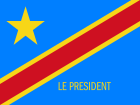Colours
The colours approximation is listed below:

Colour scheme |
Blue |
Red |
Yellow
|
| RGB |
0-127-255 |
206-16-33 |
247-214-24
|
| Hexadecimal |
#007fff |
#ce1021 |
#f7d618
|
| CMYK |
77, 51, 0, 0 |
0, 92, 84, 19 |
0, 13, 90, 3
|
| Pantone (approximate) |
299 C |
186 C |
107 C
|
Previous flags
The previous flag was adopted in 2003. It was similar to the flag used between 1960 and 1963. That flag, in turn, was based on the flag which was originally used by King Leopold's Association Internationale Africaine and was first used in 1877. The 1877 design featured a yellow star on a blue background. The 1877 flag continued as the flag of the Congo Free State after the territory was recognized as an official possession of Leopold II at the Berlin Conference.
After gaining independence from Belgium on 30 June 1960, the same basic design was maintained. However, six smaller stars were added to the hoist to symbolise the six provinces of the country at the time. This design was used only from 1960 to 1963.
The flag of the second Republic of Mobutu Sese Seko became the official banner after Mobutu established his dictatorship. This flag was used from 1966 to 1971 and consisted of the same yellow star, now made smaller, situated in the top corner of the hoist side, with a red, yellow-lined band running diagonally across the center. The red symbolized the people's blood; the yellow symbolized prosperity; the blue symbolized hope; and the star represented unity.[6]
The flag changed again when the country was renamed Zaire in 1971. The Zairean flag was created as part of Mobutu's attempted re-Africanization of the nation and was used officially until Mobutu's overthrow in the First Congo War. The flag of Zaire was also used as the political-party flag of the Popular Movement of the Revolution, led by Mobutu. This flag was adopted by the New Zaire Government in Exile formed in 2017 and was displayed used during a failed coup attempt in May 2024.
In 1997, when the Mobutu government was overthrown and the country assumed its current designation of Democratic Republic of the Congo, the country reverted to 1960s post-independence design, featuring a single large star and six smaller stars. In 2003, the most recent change before the adoption of the current flag, the flag's color was modified to use a lighter shade of blue.
-
-

Flag of
Congo-Léopoldville from independence 30 June 1960 until 1963. Also used by the rival
Congo-Stanleyville from 1960 to 1962.
-

Flag from 1963 until 1966
-

Flag from 1966 until 1971
-

Flag of
Zaire 1971–1997
-
-
-










